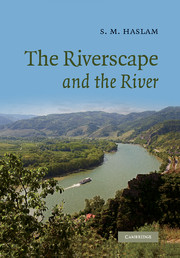Book contents
- Frontmatter
- Contents
- List of tables
- Preface
- Acknowledgements
- 1 Introduction
- 2 The natural river and its destruction
- 3 The natural riverscape and its modification
- 4 Resources I. Water resources and their loss
- 5 Development and variation of rivers
- 6 Development and variation of riverscapes
- 7 Building blocks of river vegetation
- 8 Building blocks of flood plain vegetation
- 9 Resources II. Plants and animals, cleaning and minerals
- 10 Building blocks of the riverscape
- 11 Patterns, boundaries and fragmentation
- 12 Resources III. Settlements and constructions
- 13 The harsh riverscape
- 14 The tempered or smiling riverscape
- 15 Envoi
- Bibliography
- Index to plant and animal vernacular and taxonomic names
- General subject index
11 - Patterns, boundaries and fragmentation
Published online by Cambridge University Press: 10 August 2009
- Frontmatter
- Contents
- List of tables
- Preface
- Acknowledgements
- 1 Introduction
- 2 The natural river and its destruction
- 3 The natural riverscape and its modification
- 4 Resources I. Water resources and their loss
- 5 Development and variation of rivers
- 6 Development and variation of riverscapes
- 7 Building blocks of river vegetation
- 8 Building blocks of flood plain vegetation
- 9 Resources II. Plants and animals, cleaning and minerals
- 10 Building blocks of the riverscape
- 11 Patterns, boundaries and fragmentation
- 12 Resources III. Settlements and constructions
- 13 The harsh riverscape
- 14 The tempered or smiling riverscape
- 15 Envoi
- Bibliography
- Index to plant and animal vernacular and taxonomic names
- General subject index
Summary
To save the best and forget the rest leads to over-fragmentation and loss. Fragmentation is not diversity.
Connectivity for ground dwellers is the distance to the next habitat
(Vos & Chardon, 1997)Introduction
The study of shape and pattern, of corridors, size and boundaries, is an important part of landscape ecology. At present, as with the classifications in Chapters 1, 3 and 10, methods and patterns elucidated tend to be very generalised, e.g. Bell (1999), describing the basic patterns in nature as spirals, meanders, branches and explosions. This is thought provoking and so very valuable, but difficult to apply to most riverscapes. Or they may be detailed studies of, say, the effect of a new road on a toad population, which is also valuable but also difficult to re-apply.
Fragmentation may be considered an element that degrades the overall quality of river basins (Padoa–Schioppa et al., 2006).
Scale
Scale has both an absolute and a relative effect. Figure 11.1 shows a tributary joining a meandering stream at three different scales. As a landform, scale is irrelevant, the feature is the same. There are similar erosion-sedimentation processes, similar drainage effects, and similar utilisation of the flood plain or valley bottom. However, the water space differs: (a) may support minnows, (c) should support major fish populations. A sallow bush could shade all of (a), but have a negligible effect on (c).
- Type
- Chapter
- Information
- The Riverscape and the River , pp. 260 - 280Publisher: Cambridge University PressPrint publication year: 2008



